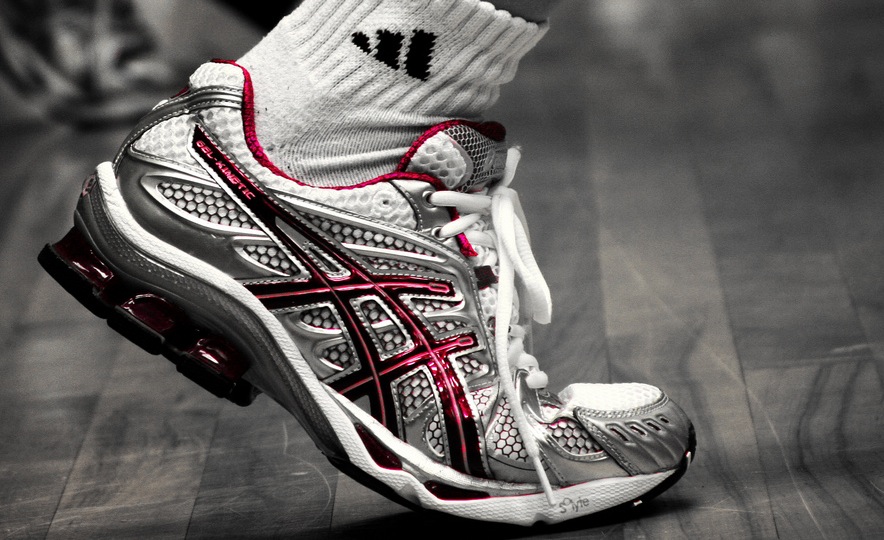
Instead, you see stupid shit about a sensor in your shoe that detects motion via an accelerometer, communicates via a wireless radio (probably Bluetooth) to a smartphone, and displays that information on your screen so that it can tell you when your shoes are wearing out.
[aditude-amp id="flyingcarpet" targeting='{"env":"staging","page_type":"article","post_id":609907,"post_type":"story","post_chan":"none","tags":null,"ai":false,"category":"none","all_categories":"business,mobile,","session":"B"}']Because you can’t, like, just look at your shoe?
Apple filed for a “Shoe Wear-Out Sensor” patent this morning. The patent application contains gems of wisdom such as “Shoes provide comfort and protection for feet.” Shockingly, the patent goes on to attest that “a shoe is often necessary to provide support during intense physical activity, such as running, soccer, and American football.”
AI Weekly
The must-read newsletter for AI and Big Data industry written by Khari Johnson, Kyle Wiggers, and Seth Colaner.
Included with VentureBeat Insider and VentureBeat VIP memberships.
Blinding flashes of the obvious for $200, Alex.
According to the patent, the technology could be used for shoes that are “rated” for a certain number of steps or time of use and that would then “expire.” (I can just see it, the new SaaS: Shoes As A Service. After $50 worth of wear, you need to re-up, plug in your credit card, and buy another year’s worth of service.)
Jeff Hammerbacher, one of Facebook’s first 100 employees, left the company after realizing that “the best minds of my generation are thinking about how to make people click ads.”
I figure that’s an upgrade on sensors for shoe wear.
But for those who want to die of boredom, or are having trouble sleeping, enjoy these patent claims. This is truly rocket science at its highest level:
1-25. (canceled)
26. A body bar sensing system, comprising: a housing having at least one detector for sensing a physical metric that indicates repeated movement of the housing when attached to the body bar; a processor configured to process the physical metric, over time, to determine repetitions thereof; and a display for informing a user of the repetitions.
27. The system of claim 26, further comprising a wireless transmitter with the housing and a watch, with a wireless receiver, remote from the housing, wherein the user views repetition information at the watch.
28. The system of claim 26, further comprising a wireless transmitter with the housing and one of a MP3 player and cell phone, with a wireless receiver, remote from the housing, wherein the user views repetition information at the MP3 player or cell phone.
29. The system of claim 26, further comprising a clamp, integrated with the housing, to retain weights on the body bar.
30-43. (canceled)
44. A body bar sensing system for sensing movement of a body bar, the body bar sensing system comprising: a housing having a coupling mechanism operative to couple to the body bar; a detector disposed within the housing and operative to sense movement of the body bar when the housing is coupled to the body bar; and a processor operative to determine a number of repetitions of the movement based on the sensed movement.
45. The body bar sensing system of claim 44, wherein the detector comprises an accelerometer.
46. The body bar sensing system of claim 44, wherein the detector is further operative to output the sensed movement as an acceleration value.
47. The body bar sensing system of claim 44, wherein the detector comprises a Hall effect sensor.
48. The body bar sensing system of claim 44, wherein the detector is operative to sense the movement by detecting inversion of the body bar.
49. The body bar sensing system of claim 44 further comprising a display operative to display the determined number of repetitions of the movement.
50. The body bar sensing system of claim 49, wherein the display is remote from the housing.
51. The body bar sensing system of claim 44 further comprising a speaker operative to output at least one sound based on the determined number of repetitions of the movement.
52. The body bar sensing system of claim 51, wherein the at least one sound comprises at least one voice annunciation.
53. The body bar sensing system of claim 52, wherein the coupling mechanism is further operative to retain at least one weight to the body bar when the body bar sensing system is coupled to the body bar.
54. A method for detecting repetitive movements of a body bar using a motion sensing system, the method comprising: detecting a physical metric associated with the body bar; processing the detected physical metric to determine whether the detected physical metric indicates a repetitive motion of the body bar; determining a current number of repetitive movements of the body bar based on the processing; and providing the determined current number of repetitive movements to a user.
55. The method of claim 54, wherein the detecting comprises detecting an acceleration of the body bar.
56. The method of claim 54, wherein the processing comprises detecting when the body bar is at least one of raised and lowered within a predefined time interval.
57. The method of claim 54, wherein the detecting comprises detecting an inversion of the body bar.
58. The method of claim 54, wherein the providing comprises displaying the determined current number of repetitive movements.
59. The method of claim 54, wherein the providing comprises transmitting the determined current number of repetitive movements to an external device.
photo credit: IvanClow via photopin cc, Hat tip: AppleInsider
[aditude-amp id="medium1" targeting='{"env":"staging","page_type":"article","post_id":609907,"post_type":"story","post_chan":"none","tags":null,"ai":false,"category":"none","all_categories":"business,mobile,","session":"B"}']
VentureBeat's mission is to be a digital town square for technical decision-makers to gain knowledge about transformative enterprise technology and transact. Learn More